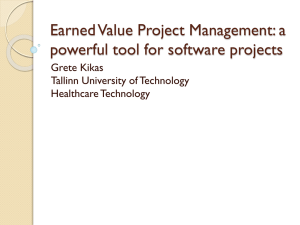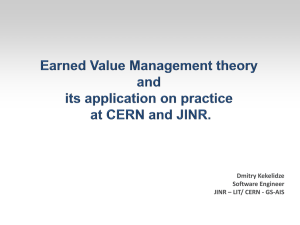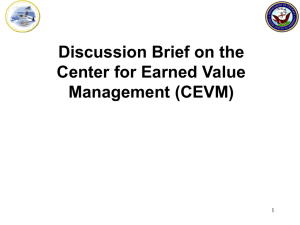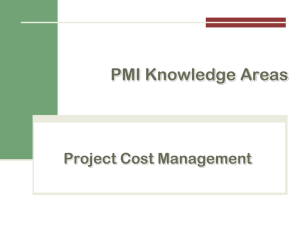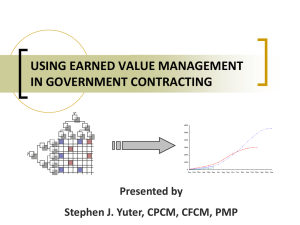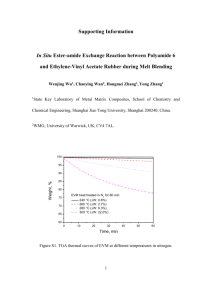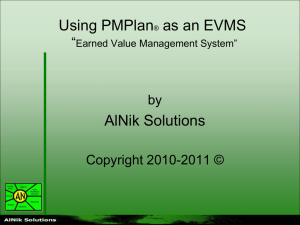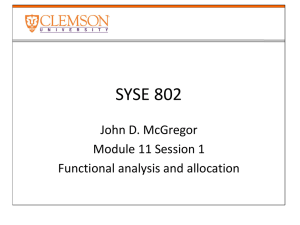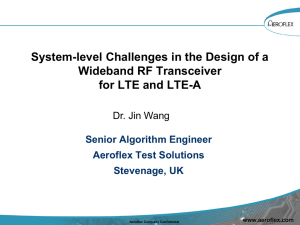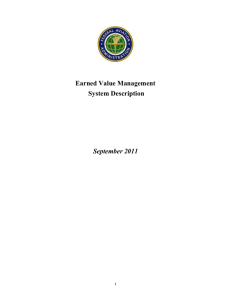2 Discussion
advertisement
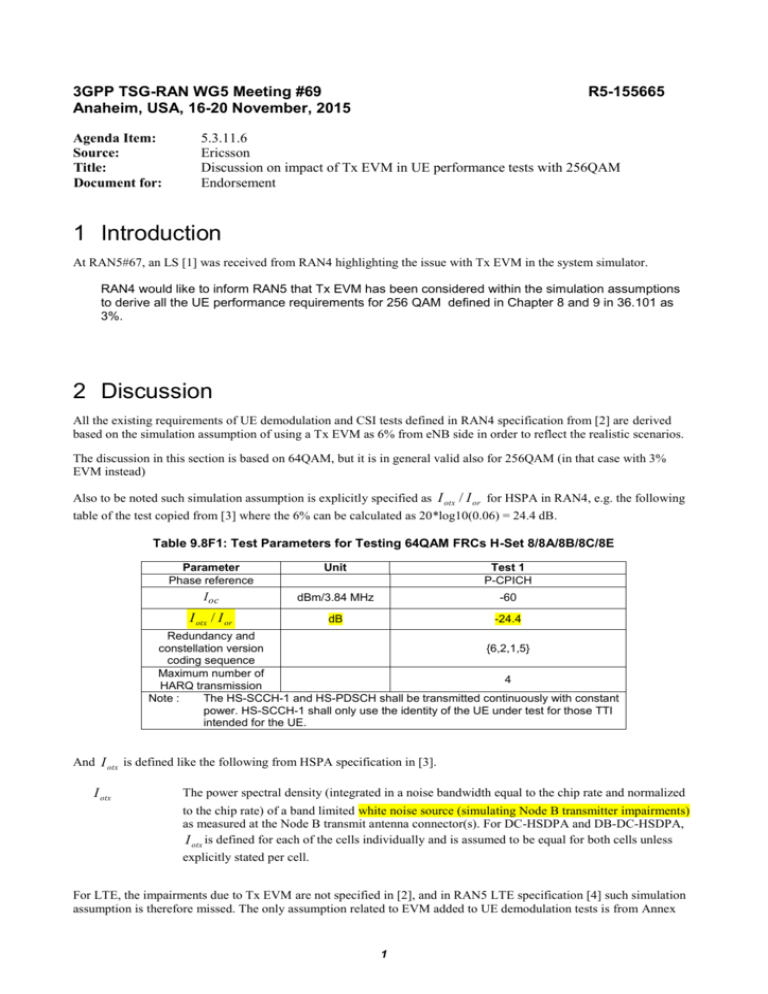
3GPP TSG-RAN WG5 Meeting #69
Anaheim, USA, 16-20 November, 2015
Agenda Item:
Source:
Title:
Document for:
R5-155665
5.3.11.6
Ericsson
Discussion on impact of Tx EVM in UE performance tests with 256QAM
Endorsement
1 Introduction
At RAN5#67, an LS [1] was received from RAN4 highlighting the issue with Tx EVM in the system simulator.
RAN4 would like to inform RAN5 that Tx EVM has been considered within the simulation assumptions
to derive all the UE performance requirements for 256 QAM defined in Chapter 8 and 9 in 36.101 as
3%.
2 Discussion
All the existing requirements of UE demodulation and CSI tests defined in RAN4 specification from [2] are derived
based on the simulation assumption of using a Tx EVM as 6% from eNB side in order to reflect the realistic scenarios.
The discussion in this section is based on 64QAM, but it is in general valid also for 256QAM (in that case with 3%
EVM instead)
Also to be noted such simulation assumption is explicitly specified as I otx / I or for HSPA in RAN4, e.g. the following
table of the test copied from [3] where the 6% can be calculated as 20*log10(0.06) = 24.4 dB.
Table 9.8F1: Test Parameters for Testing 64QAM FRCs H-Set 8/8A/8B/8C/8E
Parameter
Phase reference
Unit
Test 1
P-CPICH
I oc
dBm/3.84 MHz
-60
I otx / I or
dB
-24.4
Redundancy and
constellation version
{6,2,1,5}
coding sequence
Maximum number of
4
HARQ transmission
Note :
The HS-SCCH-1 and HS-PDSCH shall be transmitted continuously with constant
power. HS-SCCH-1 shall only use the identity of the UE under test for those TTI
intended for the UE.
And I otx is defined like the following from HSPA specification in [3].
I otx
The power spectral density (integrated in a noise bandwidth equal to the chip rate and normalized
to the chip rate) of a band limited white noise source (simulating Node B transmitter impairments)
as measured at the Node B transmit antenna connector(s). For DC-HSDPA and DB-DC-HSDPA,
I otx is defined for each of the cells individually and is assumed to be equal for both cells unless
explicitly stated per cell.
For LTE, the impairments due to Tx EVM are not specified in [2], and in RAN5 LTE specification [4] such simulation
assumption is therefore missed. The only assumption related to EVM added to UE demodulation tests is from Annex
1
F.1.4 Table F.1.4-1: Maximum Test System Uncertainty for Performance Requirements as copied as following for the
sustained data rate tests from [4], only applicable to this test case. For other demod test cases there are currently no
requirments on test equipment downlink EVM.
8.7.1.1 FDD sustained data rate
performance
Downlink absolute
power uncertainty,
averaged over BW Config
±1.0 dB
Downlink EVM ≤ 3%
3% EVM is equivalent to a Test system
downlink SNR of 30.5dB. The noise from the
Test system is then sufficiently below that
required for the UE to demodulate the signal
with the required % success rate. Under these
conditions the UE throughput is limited by the
Reference measurement channel and the UE
capability, and not by the Test system EVM.
With such simulation assumption missed in RAN5 specification in [4] it will lead to a mismatch to the requirement
defined in RAN4 specification in [2]. If test system has < 6% EVM the tests will be performed under easier conditions
than the simulation assumptions. In Table 1 the impact of different Tx EVM in terms of SNR under the static condition
is calculated for different SNR values. So it can be seen with SNR level at 25 dB if only 3% Tx EVM is assumed from
RAN5 but 6% Tx EVM is assumed from RAN4, the difference in SNR difference could be 2,21dB at static condition.
Observation 1: The mismatching on Tx EVM between RAN4 and RAN5 could lead to performance difference up
to 2~3dB.
Observation 2: The biggest mismatch occurs in test cases with higher order modulation due to requiring a high
SNR
SNR with
ideal
transmitter
Table 1 SNR impact with different Tx EVM under static condition
SNR in simulation
Real
Real SNR in tests
SNR difference from
assumption (with 6%
Test
considering EVM
simulation
EVM as RAN4
system
[dB]
assumption [dB]
assumption)
EVM
[%]
25
-21,70
1
-24,86
3,17
25
-21,70
2
-24,48
2,78
25
-21,70
3
-23,91
2,21
25
-21,70
6
-21,70
0,00
20
-18,66
1
-19,96
1,29
20
-18,66
2
-19,83
1,17
20
-18,66
3
-19,63
0,96
20
-18,66
6
-18,66
0,00
15
-14,53
1
-14,99
0,45
15
-14,53
2
-14,95
0,41
15
-14,53
3
-14,88
0,35
15
-14,53
6
-14,53
0,00
10
-9,85
1
-10,00
0,15
10
-9,85
2
-9,98
0,14
10
-9,85
3
-9,96
0,11
10
-9,85
6
-9,85
0,00
2
In order to have RAN5 test cases that are performed under the same conditions as when the performance limits were
decided in RAN4 this issue needs to be addressed.
The technical solution in the test equipment (TE) is however not trivial. Some options are:
Option 1: Do nothing
Problems:
a) A UE that has 3 dB worse performace than the RAN4 intended minimum requirement can pass the test.
b) A compliant UE can fail the test if the inherent TE EVM is higher than in the simulation assumptions.
Option 2: Add requirement in annex F on TE EVM (upper limit)
This solves problem b in option 1, but it does not solve the main problem (problem a)
Option 3: Model EVM as in HSPA with a noise floor at -30 dB (3% EVM equivalent) for 256QAM demodulation
test cases.
This solves problem a in option 1, but not problem b
Option 4: Require test equipment to have exactly 3% EVM for 256QAM demodulation test cases
This solves both problem a and b, but could be complex to handle in the TE since it needs to balance two parts, 1)
Inherent EVM in transmitter 2) Additional simulated impairments. The TE has control over (can adjust) part 2, but
not part 1.
3 Proposals
It is proposed that
Proposal 1: To agree that there is a mismatch between RAN4 simulation assumptions as informed in LS to RAN5 [1]
and RAN5 demodulation test cases for 256QAM added at RAN5#69 with regard to the TX EVM as follows.
RAN4: Performance requirements defined under the assumption of 3% TX EVM
RAN5: The resulting impact on the RAN5 test settings or requirements of the above assumption has not yet been
fully analyzed and is under investigation.
Proposal 2: To limit any possible solution of the problem to 256QAM demodulation test cases to avoid major impact to
legacy test cases
Proposal 3: To agree on a solution. Option 3 is proposed because it is easy to implement and the solution common with
HSPA.
4 References
[1] R4-151179, “LS on clarification of Tx EVM from RAN4 to RAN5”, RAN4 (Ericsson)
[2] TS 36.101, v12.9.0
[3] TS 25.101, v12.7.0
[4] TS 36.521-1, v12.7.0
[5] R4-146653, RAN4 simulation assumptions for 256 QAM
3


